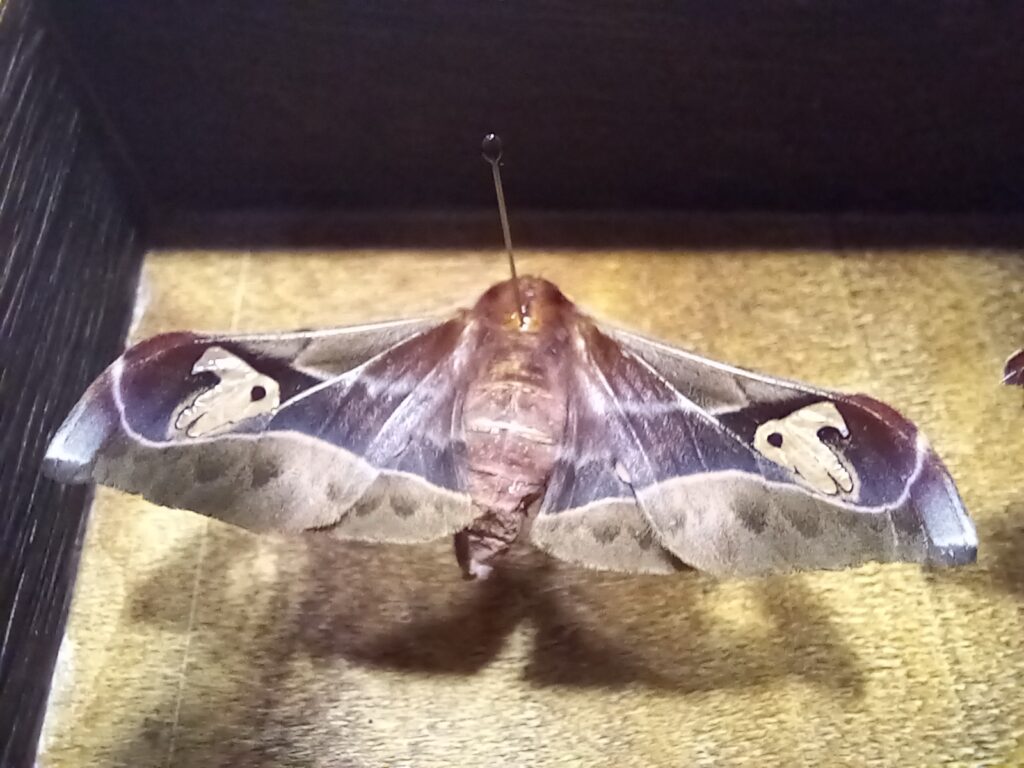Holocerina angulata
Holocerina angulata ist eine relativ kleine Saturniidae Art aus Afrika. Die Männchen sind deutlich kleiner als die Männchen. Besonders bei dieser Art ist vor allem, dass die Raupen sehr variabel gefärbt sind. Die Schwierigkeit der Zucht dieser Art liegt auf einer Skala von 1 bis 10 bei 5 bis 6. Dabei ist zu beachten, dass die Zucht der Raupen etwa bei 4, die Paarung aber bei 7 bis 8 liegt.

Die Eier dieser Art sind ziemlich klein. Sie müssen feucht und luftig gelagert werden. Dabei ist das Setup hier: link to setup beschrieben perfekt.
Die frisch geschlüpften Raupen sind schwarz und haben einen orangenen Fleck am Rücken. Sie sind sehr polyphag. Unter anderem fressen sie Liguster aller Arten, Kirschlorbeer, Robinie, Ficus usw. Die natürliche Futterpflanze ist Liguster. Sie sind nicht besonders empfindlich. Wie üblich können die Raupen mit einem feinen Pinsel auf die Futterpflanze in einer geschlossenen Plastikbox gegeben, kurz angesprüht und dann für einige Stunden dunkel gestellt werden. Wenn jeden Tag sauber gemacht wird verläuft die Zucht bis L3 problemlos.
Ab L3 sollten die Raupen besser durchlüftet werden. Entweder wird auf luftige Boxen umgestellt, oder die Zucht wird in Netzkäfigen fortgesetzt. Die Raupen sind ab L3 sehr variabel. Sie können schwarz-weis, braun-schwarz, braun-weiß, schwarz gelb oder braun-gelb sein. Theoretisch können auch noch andere Variationen auftreten. Die Haare der Raupen können nesseln, ähnlich wie Automeris Spezies. Bis sich die Raupen zum Verpuppen vorbereiten dauert es etwa 6 bis 8 Wochen. Sie werden bis zu 7 cm groß.
Die Raupen bauen entweder ganz feine Kokons oder verpuppen sich direkt am Boden. Ihnen muss jedenfalls keine eigene Box zur Verfügung gestellt werden. Bereits anhand der Größe der Puppen kann man Männchen und Weibchen eindeutig unterscheiden. Sie werden bis zum Schlupf auf einem weichen Untergrund gehalten. Gelegentliches sprühen ist hilfreich. Die größte Challenge der Zucht ist die Paarung. Die Männchen haben eine Flügelspannweite um die 5 cm und sind nur für 3 bis 4 Tage paarungsfähig. Weibchen benötigen in ihrer Entwicklung deutlich länger und haben eine Flügelspannweite bis zu 10 cm. Häufig sind bereits alle Männchen gestorben, wenn die Weibchen schlüpfen. In einen Netzkäfig (optimalerweise 40x40x60) darf nur ein Weibchen mit 1 bis 2 Männchen gehalten werden. Die Weibchen dieser Art legen bis zu 250 Eier ab.
Holocerina angulata ist eine einfache Art bis es zur Paarung kommt. Diese kann oft aber nicht beeinflusst werden und es ist viel Glück im Spiel. Aufgrund der Variabilität der Raupen gehört diese Art aber zu meinen absoluten Lieblingsarten. Auch die Falter mit ihrer fledermausartigen Flügelform sind eine Besonderheit, die sich kein Züchter entgehen lassen soll.
English version:
Holocerina angulata is a relatively small species of Saturniidae found in Africa. The males are notably smaller than the females. What is particularly striking about this species is the remarkable variability in the coloration of its caterpillars. The difficulty level of breeding this species ranges from 5 to 6 on a scale of 1 to 10, with the caterpillar rearing at around 4 and mating at 7 to 8 being key considerations.
The eggs of this species are quite small and require a humid and airy storage environment. The setup described here: link to setup is perfect for this purpose.
Newly hatched caterpillars are black with an orange spot on their backs. They are highly polyphagous and feed on various plants, including different types of privet, cherry laurel, locust, ficus, and more. Their natural food source is privet, and they are not particularly sensitive. As is customary, the caterpillars can be placed on the food plant in a closed plastic container using a fine brush, lightly sprayed, and then kept in darkness for several hours. With daily cleaning, the breeding process proceeds smoothly up to the L3 stage.
From the L3 stage onwards, it’s better to provide better ventilation for the caterpillars. You can either switch to airy containers or continue breeding them in mesh cages. The caterpillars exhibit significant variability from L3 onwards, with possible colorations including black-and-white, brown-and-black, brown-and-white, black-and-yellow, or brown-and-yellow. The caterpillar hairs can be irritating, similar to Automeris species. It takes about 6 to 8 weeks for the caterpillars to prepare for pupation, and they can grow up to 7 cm in length.
The caterpillars either build very fine cocoons or pupate directly on the ground, so they don’t need separate containers. Gender differentiation is quite clear based on the size of the pupae. They should be kept on a soft substrate until they emerge, with occasional spraying being helpful. The biggest challenge in breeding is mating. The males have a wingspan of around 5 cm and are only fertile for 3 to 4 days. Females, on the other hand, take considerably longer to develop and have a wingspan of up to 10 cm. Often, all the males have died by the time the females emerge. In a mesh cage (ideally 40x40x60 cm), only one female should be housed with 1 to 2 males. Females of this species can lay up to 250 eggs.
Holocerina angulata is a straightforward species to raise until it comes to mating, which can often be beyond one’s control and heavily reliant on luck. However, due to the caterpillars‘ variability, this species is among my absolute favorites. Additionally, the moths, with their bat-like wing shape, are a unique feature that no breeder should miss out on.